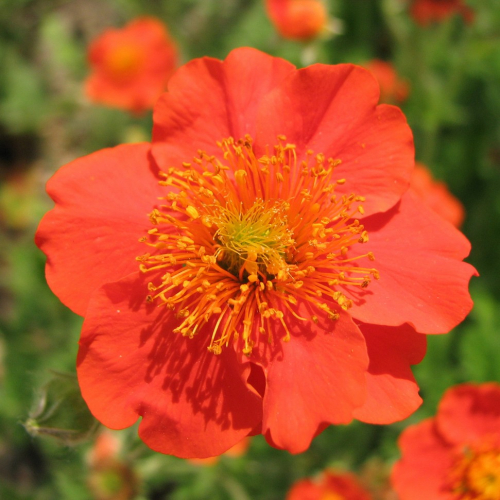Perennials Gеum

Description
Special Features of Avens
Avens, or Geum, is genus of perennial plants in the rose family Rosaceae. These flowering plants are hardy and very common in temperate cimates where they occur mainly in forests, gardens, meadows, along roads and near water.
The origin of the Latin word "geum" is unclear. It might come from Greek word for "tasty, nice". The Russian name "Gravilat" goes back to the name of a drug made from a very popular plant Geum urbanum. Its roots have long been used in medicine, and the drug was called "Caryophillata" (radix caryophyllatae), and after a while first "Graphilat" and then "Gravilat". The plant is commonly known as Colewort, Herb Bennet, Wild Rye, Way Bennet, and Goldy Star. Clove Root. Other names for Geum Rivale the plant are Water avens, Purple avens,, Nodding Avens, Drooping Avens, Cure-All, Water Flower, and indian Chocolate.
Geum grows 20 to 75 cm tall, depending on species. The stems are upright. The rhizome is thick and hard, with a pleasant clove-like flavour. The leaves are large, feathery, green, more or less covered with hairs, collected in the rosette. Simple, semi-double, or double flowers (3-4 cm in diameter) are bowl-shaped, can be single ir collected in panicles or corymboses. They are predominantly yellow, pink, or red tones. Geum blossoms in May and July and can re-bloom in the autumn. The fruit is a box with uniquely shaped seeds.
According to various sources, the genus includes 30-50 species but only some of them are popular in cultivation:
Wood avens (Geum urbanum) grows 60 cm tall and has small single yellow flowers.
Alpine avens (Geum montanum) gows low (about 15 cm tall) and has wrinkled leaves and yellow flowers.
Water avens (Geum rivale) can grow to 70 cm tall and has brown stems, pale green, leaves and drooping flowers of white, pinkish beige, or pale yellow colour.
Chilean avens (Geum chiloense) grows to about half a meter tall and has attractive flowers, usually red, collected in panicules. The popular garden varieties have double flowers, for example: ‘Mrs J. Bradshow' (orange flowers), ‘Lady Stratheden' (yellow flowers), and ‘Fireball' (orange-red flowers).
Dwarf orange avens (Geum coccineum) grows up to 40 cm in height, and has rich red or bright orange flowers up to 3 cm in diameter. Varieties with double flowers are particularly popular.
Prairie smoke or Three-flowered avens (Geum triflorum) is a low growing plant with yellow and red flowers. It prefers moist and rocky soils.
Yellow avens or Common avens (Geum Aleppicum) grows up to 65 cm tall and is notable for its rich yellow flowers.
Hybrid avens (Geum hybridum) includes mixed varieties with a wide range of colouring and the degree of doubleness: ‘Princess Juliana' with orange yellow flowers, ‘Fire Opal' with orange red flowers, and ‘Rubin' with scarlet flowers.
In the garden, Geum looks great in beds, edges, mixed borders, rock gardens, and border beds. The best companions are Peonies, Primroses, Carnations, Bugle, Campanulla, Phlox, Brunnera, and Dicentra. Low-growing varieties can be grown as a container culture. Tall species are good for cutting and have a long vase life. Geum Rivale is indispensable for decorating garden ponds.
What is more, Geum is a medicinal plant. Its roots are rich in tannins, heinic glycoside, starch, and essential oil, and its leaves contain ascorbic acid and carotene. Geum is widely used in medicine as an anti-inflammatory, haemostatic, wound healing and tonic agent. Infusions made from the rhizomes are considered helpful in gastrointestinal, liver, kidneys, and otolaryngological diseases. Geum also used in cooking and considered an aphrodisiac. The young leaves of the plant are edible, the rhizome can be used as seasoning for various dishes and for flavouring ale or white wine.
The Secrets to Successfully Growing Avens
Because of its hardiness and frost-resistance, Geum does not require special care. Any drained soil, except for acidic, will do. Geum loves light but can grow in the shaded areas as well. The basic care involves watering in dry weather (avoid waterlogging), weeding, deadheading to prevent self-seeding, pruning and mulching, especially in the autumn. Geum withstands temperatures down to -30 ° C; the varieties with double flowers are more sensitive to lower temperature, so they will need winter sheltering with dry leaves or spruce branches. All Geum species respond well to compound fertilizers. Feed the plant twice per season. Every 3 to 4 years rejuvenate the plant by dividing the shrub. This will help to keep it attractive and flowering for a long time.
Divide the shrub in the spring or in August-September after seeds ripen. To do this, carefully dig up the shrub using a shovel, divide it into parts, each of which will contain the roots, the rosette of leaves, and at least one bud, and plant in a prepared location spacing 20-30 cm apart. Before planting, add compost or peat and water the soil.
Geum can be propagated by seeds that are planted in the open ground in the spring, as well as in cold frames or under glass to a depth of 1 cm. Due to frequent spring frosts common in our climate, it is better to sow for seedlings. To keep the soil moist, cover the seedlings with PE film or glass, ventilate and carefully water. When the seedlings develop true leaves, prick and planted to a permanent place in July and August. The young plants will bloom only in the next season.
Potential Problems
Geum is very disease and pest resistant. With the proper care, the plant does not need preventive application of chemicals. Only in rare cases in the waterlogged soil, Avens may be affected by root rot. Remove hopelessly diseased plants with the soil and burn, and treat the remaining plants with fungicides.







 305
305







